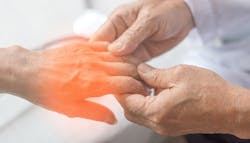Skin assessments key to preventing pressure injuries
Nursing assessments of patients’ skin conditions may seem routine, but an analysis of more than 5,000 patient records underscores the importance of treating and monitoring irritated skin early and eliminating the cause as an important step to prevent pressure injuries, announced the American Association of Critical-Care Nurses (AACN).
"Risk Factors for Hospital-Acquired Pressure Injury (HAPI) In Surgical Critical Care Patients" examined data in electronic health records (EHRs) related to nursing skin assessments, along with other factors. The study is published in American Journal of Critical Care (AJCC).
The results reinforce that changes in the skin, such as irritation and redness, should be considered influential risk factors for HAPI and promptly treated by eliminating the cause.
Co-author Jenny Alderden, PhD, APRN, CCRN, CCNS, is an assistant professor at the University of Utah College of Nursing, Salt Lake City. She is a critical care nurse specialist with expertise in pressure injury risk assessment and prevention and serves on the University of Utah pressure injury prevention committee. In addition to the research team at the University of Utah, leading pressure injury researchers from Duke University School of Nursing, Durham, North Carolina, and the Department of Veteran Affairs James. A. Haley Veterans’ Hospital and Clinics, Tampa, Florida, provided expertise for the project.
“This study demonstrates the power of using informatics to analyze the vast amounts of data in electronic health records,” Alderden said. “Critical care nurses routinely conduct head-to-toe skin assessments every 12 hours and document changes in condition in the EHR. Modern informatics approaches enable us to more easily examine large-scale, real-world data available in the health record to gain insights and improve outcomes.”
The retrospective cohort study included data from surgical critical care patients admitted to the surgical intensive care unit (ICU) or cardiovascular surgical ICU at the University of Utah Hospital, Salt Lake City, from 2014 through 2018. The research team analyzed five years of data from 5,101 patients using a modern statistical test called Least Absolute Shrinkage and Selection Operator (LASSO).
Of the 399 patients in the sample who had a HAPI develop, 110 patients had a stage 1 pressure injury develop, with 40 percent (44) worsening to a more severe stage during their ICU stay.
The most common pressure injury location was the coccyx, followed by the buttocks, sacrum and an extremity excluding the heel.
The research builds on the team’s ongoing work to develop and test its machine learning model to predict pressure injury development in critical care patients. The long-term goal is to develop a predictive model that will be deployed in the EHR to provide real-time decision support, enabling nurses to identify patients at highest risk for pressure injury and to apply targeted interventions.
